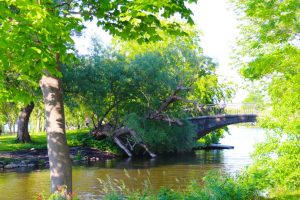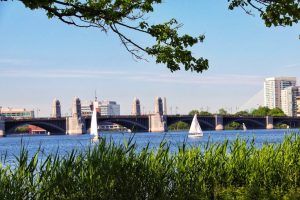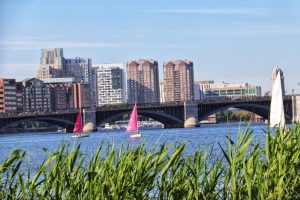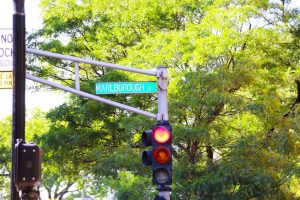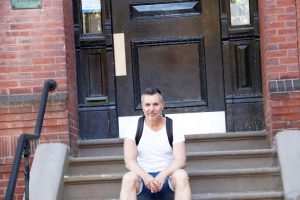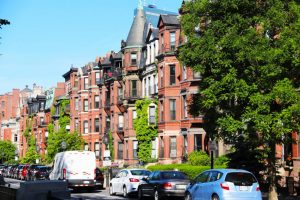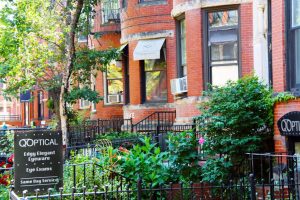Features, Travel, United States of America 0 comments
Boston, Massachusetts, USA
I love Boston
Boston is my favorite city in the United States. A few years ago I was lucky enough to live there for a long period of time. I lived very centrally, only a few minutes walk from the city center and Charles River. Marlborough Street, that’s where I lived.
You can’t get out of the rapture. When you walk down the back streets of Boston, you might think you were in England. Brick houses, about 67,000 electric streetlights and 2,800 gas lamps. Boston combines tradition and modernity and is the capital of Massachusetts. Its European flair enchants visitors with many tourist attractions. It is a city with a history. No other American city can look back on such a long tradition as Boston.
You have probably heard a lot about Harvard University in Cambridge or the renowned M.I.T. (Massachusetts Institute of Technology). Both are easy to reach by subway, take the Red Line subway. If you like classical music, I recommend the world famous Boston Symphony Orchestra, The Boston Pops “.
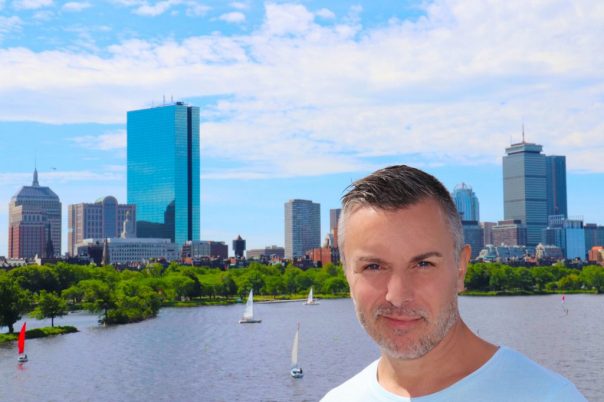
Old and new, you will find a harmonious combination here. On one side the venerable Beacon Hill, on the other side the trendy South End. Here modern skyscrapers, there historic row houses. Here the extensive green of the Boston Common, there the hustle and bustle of the modern harbour. Many corners remind of European cities, but Boston is also a typical American city. It ranges from the Italian North End to Chinatown and the Irish Charlestown to the African-American Roxbury.
I love Boston
Boston is my favorite city in the United States. A few years ago I was lucky enough to live there for a long period of time. I lived very centrally, only a few minutes walk from the city center and Charles River. Marlborough Street, that’s where I lived.

You can’t get out of the rapture. When you walk down the back streets of Boston, you might think you were in England. Brick houses, about 67,000 electric streetlights and 2,800 gas lamps. Boston combines tradition and modernity and is the capital of Massachusetts. Its European flair enchants visitors with many tourist attractions. It is a city with a history. No other American city can look back on such a long tradition as Boston.
You have probably heard a lot about Harvard University in Cambridge or the renowned M.I.T. (Massachusetts Institute of Technology). Both are easy to reach by subway, take the Red Line subway. If you like classical music, I recommend the world famous Boston Symphony Orchestra, The Boston Pops “.
Old and new, you will find a harmonious combination here. On one side the venerable Beacon Hill, on the other side the trendy South End. Here modern skyscrapers, there historic row houses. Here the extensive green of the Boston Common, there the hustle and bustle of the modern harbour. Many corners remind of European cities, but Boston is also a typical American city. It ranges from the Italian North End to Chinatown and the Irish Charlestown to the African-American Roxbury.
John Hancock Tower
John Hancock Tower is located at 200 Clarendon Street, previously John Hancock Tower and colloquially known as The Hancock, is a 62-story, 790-foot (240 m) skyscraper in Boston, Massachusetts.
The tower was designed by Pei Cobb Freed & Partners for John Hancock Insurance Company and completed in 1976. When it was designed, the structure defied conventional construction designs. The architects chose a minimalist exterior made entirely of glass. Though the building is iconic, it was known for its many engineering flaws. It reacts to gusty winds and starts swaying even though the 44-square feet long glass panes stay in place. The center portion of the building keeps twisting and bending. Nearly 65 of the 10,344 glass panes have come crashing down to the ground due to their separation from the lead solder.
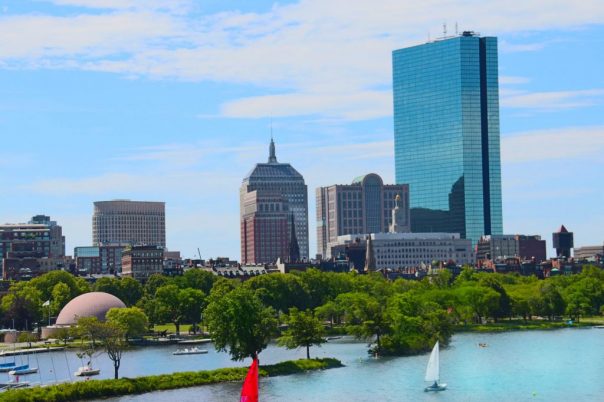
As a result of these flaws, the structure is being constantly monitored, inspected and repaired. In order to decrease the torsion caused by the twisting and bending, dampeners and steel braces weighing thousands of tons have been placed. The observation tower which was a tourist attraction has been closed after the September 11, 2001 attacks. Despite all its troubles, the tower still remains a captivating sight.
John Hancock Tower
John Hancock Tower is located at 200 Clarendon Street, previously John Hancock Tower and colloquially known as The Hancock, is a 62-story, 790-foot (240 m) skyscraper in Boston, Massachusetts.

The tower was designed by Pei Cobb Freed & Partners for John Hancock Insurance Company and completed in 1976. When it was designed, the structure defied conventional construction designs. The architects chose a minimalist exterior made entirely of glass. Though the building is iconic, it was known for its many engineering flaws. It reacts to gusty winds and starts swaying even though the 44-square feet long glass panes stay in place. The center portion of the building keeps twisting and bending. Nearly 65 of the 10,344 glass panes have come crashing down to the ground due to their separation from the lead solder.
As a result of these flaws, the structure is being constantly monitored, inspected and repaired. In order to decrease the torsion caused by the twisting and bending, dampeners and steel braces weighing thousands of tons have been placed. The observation tower which was a tourist attraction has been closed after the September 11, 2001 attacks. Despite all its troubles, the tower still remains a captivating sight.
The Hatch Shell
From my flat to The Hatch Shell I had only 5 minutes to go.
The ‘Hatch Shell’, as it has come to be known, is Boston’s epicenter for large outdoor performances and open-air events. Emblazoned in bronze lettering on the face of the steps are the names of some of the world’s greatest composers. Classical, local and international, Oldies, Blues, Jazz, and Rock and Roll performances are held from spring through fall amidst one of the most charming and historical cities of our nation. The most notable event happens every July 4th as Keith Lockhart conducts the Boston Pops during Boston’s Independence Day celebration on July 4th. A patriotic score, including Tchaikovsky’s 1812 Overture, accompanies a grand finale display of blazing fireworks over the Charles River. For many visitors, a blanket, picnic cooler, and family members on the Hatch Shell lawn is the perfect way to spend a warm summer evening.
Boston Pops
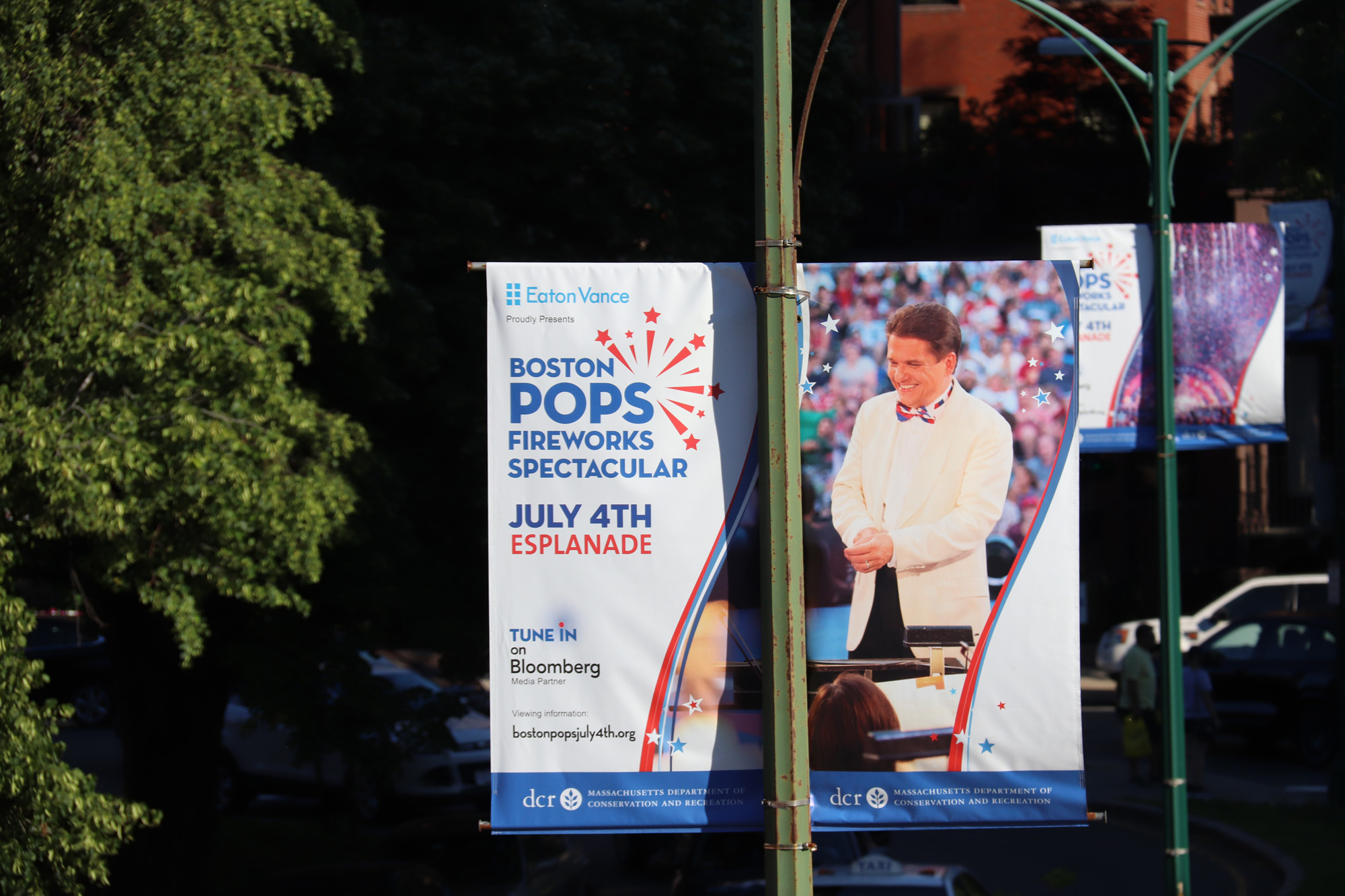
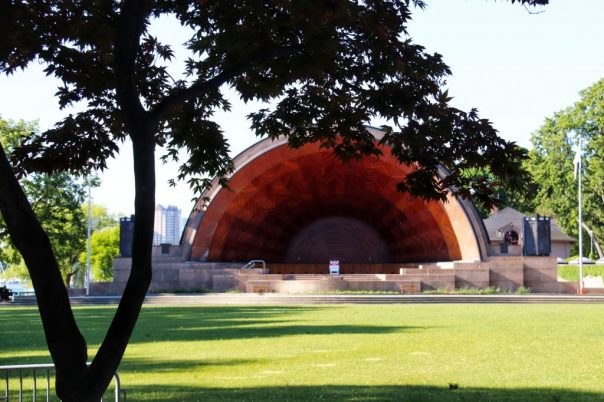
The Boston Symphony Orchestra gave its inaugural concert on October 22, 1881, under Georg Henschel, who remained as conductor until 1884. For nearly twenty years, BSO concerts were held in the old Boston Music Hall; Symphony Hall, one of the world’s most revered concert halls, opened on October 15, 1900. Henschel was succeeded by the German-born and -trained conductors Wilhelm Gericke, Arthur Nikisch, Emil Paur, and Max Fiedler, culminating in the appointment of the legendary Karl Muck, who served two tenures, 1906-08 and 1912-18. In 1915 the orchestra made its first transcontinental trip, playing thirteen concerts at the Panama-Pacific International Exposition in San Francisco. Henri Rabaud, engaged as conductor in 1918, was succeeded a year later by Pierre Monteux. These appointments marked the beginning of a French tradition maintained, even during the Russian-born Serge Koussevitzky’s tenure (1924-49), with the employment of many French-trained musicians.
The Hatch Shell
From my flat to The Hatch Shell I had only 5 minutes to go.

The ‘Hatch Shell’, as it has come to be known, is Boston’s epicenter for large outdoor performances and open-air events. Emblazoned in bronze lettering on the face of the steps are the names of some of the world’s greatest composers. Classical, local and international, Oldies, Blues, Jazz, and Rock and Roll performances are held from spring through fall amidst one of the most charming and historical cities of our nation. The most notable event happens every July 4th as Keith Lockhart conducts the Boston Pops during Boston’s Independence Day celebration on July 4th. A patriotic score, including Tchaikovsky’s 1812 Overture, accompanies a grand finale display of blazing fireworks over the Charles River. For many visitors, a blanket, picnic cooler, and family members on the Hatch Shell lawn is the perfect way to spend a warm summer evening.
Boston Pops

The Boston Symphony Orchestra gave its inaugural concert on October 22, 1881, under Georg Henschel, who remained as conductor until 1884. For nearly twenty years, BSO concerts were held in the old Boston Music Hall; Symphony Hall, one of the world’s most revered concert halls, opened on October 15, 1900. Henschel was succeeded by the German-born and -trained conductors Wilhelm Gericke, Arthur Nikisch, Emil Paur, and Max Fiedler, culminating in the appointment of the legendary Karl Muck, who served two tenures, 1906-08 and 1912-18. In 1915 the orchestra made its first transcontinental trip, playing thirteen concerts at the Panama-Pacific International Exposition in San Francisco. Henri Rabaud, engaged as conductor in 1918, was succeeded a year later by Pierre Monteux. These appointments marked the beginning of a French tradition maintained, even during the Russian-born Serge Koussevitzky’s tenure (1924-49), with the employment of many French-trained musicians.
Charles River
In summer the area around the Charles River is very popular with the people. You can take a walk, have a picnic with friends. There are no limits set.
The Charles River flows 80 miles from Hopkinton, Mass. to Boston Harbor. The Charles River is the most prominent urban river in New England. It is a major source of recreation and a readily-available connection to the natural world for residents of the Boston metropolitan area. The entire Charles River drains rain and melted snow from a watershed area of 310 square miles. Two hundred and sixty-eight square miles of that watershed area drain over the Watertown Dam into the Lower Charles River. The remaining 42 square miles drain directly into the Lower Charles River.
The headwaters of the Charles River are in Hopkinton, Massachusetts. From there, the river flows through the municipalities of Milford, Bellingham, Franklin, Medway, Millis, Medfield, Sherborn, Dover, Natick, Wellesley, Needham, Dedham, Newton, Waltham, Watertown, Cambridge and Boston, MA and from there into Boston Harbor.
Charles River
In summer the area around the Charles River is very popular with the people. You can take a walk, have a picnic with friends. There are no limits set.
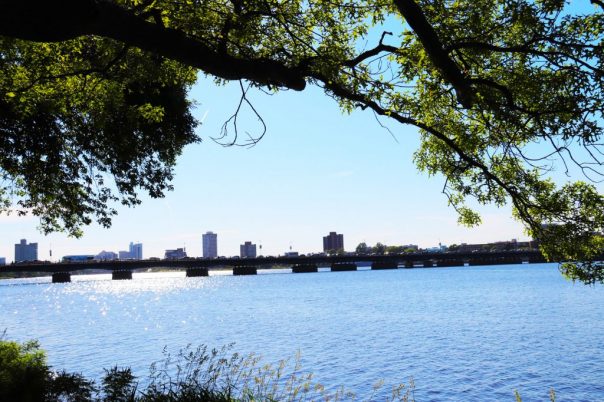
The Charles River flows 80 miles from Hopkinton, Mass. to Boston Harbor. The Charles River is the most prominent urban river in New England. It is a major source of recreation and a readily-available connection to the natural world for residents of the Boston metropolitan area. The entire Charles River drains rain and melted snow from a watershed area of 310 square miles. Two hundred and sixty-eight square miles of that watershed area drain over the Watertown Dam into the Lower Charles River. The remaining 42 square miles drain directly into the Lower Charles River.
The headwaters of the Charles River are in Hopkinton, Massachusetts. From there, the river flows through the municipalities of Milford, Bellingham, Franklin, Medway, Millis, Medfield, Sherborn, Dover, Natick, Wellesley, Needham, Dedham, Newton, Waltham, Watertown, Cambridge and Boston, MA and from there into Boston Harbor.
Marlborough Street
If you are traveling to Boston, you absolutely must explore the entire Back Bay area.
Starting from Newbury street, Beacon Street and of course Marlborough Street, the street where I lived. You will find brownstones houses, beautiful front gardens, gas lanterns and beautiful trees. Marlborough street runs parallel to Beacon Street, Comonwealth Avenue, Newbury Sreet, Boylston Street. You will find exclusive apartments and boutiques on every street. On the west side is Mass Ave and on the east side you will get to the public garden and Beacon Hill. All worth seeing tourist attractions are easily reach by foot.
Boston’s Back Bay Area: The unique mix of affluent residential streets and commercial attractions undoubtedly makes Back Bay one of the most visitor-friendly neighborhoods in Boston. This centrally located neighborhood is not only home to some of the city’s most important architectural landmarks, but is also the hub’s main shopping destination; you’ll find everything from global mega-chains to small indie shops and state-of-the-art designer boutiques. But it hasn’t always been like this – less than 200 years ago, when the entire area, from public gardens to swamps, was submerged in marshland; a massive landfill project to meet the needs of a growing population made the area what it is today. If you’re tired of Back Bay, you can do even more by checking out our guides to the best restaurants in Boston, the best live music in Boston, and the best museums in Boston.
Marlborough Street
If you are traveling to Boston, you absolutely must explore the entire Back Bay area.
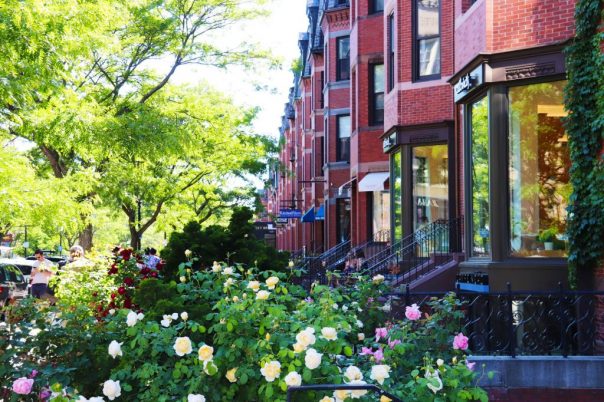
Starting from Newbury street, Beacon Street and of course Marlborough Street, the street where I lived. You will find brownstones houses, beautiful front gardens, gas lanterns and beautiful trees. Marlborough street runs parallel to Beacon Street, Comonwealth Avenue, Newbury Sreet, Boylston Street. You will find exclusive apartments and boutiques on every street. On the west side is Mass Ave and on the east side you will get to the public garden and Beacon Hill. All worth seeing tourist attractions are easily reach by foot.
Boston’s Back Bay Area: The unique mix of affluent residential streets and commercial attractions undoubtedly makes Back Bay one of the most visitor-friendly neighborhoods in Boston. This centrally located neighborhood is not only home to some of the city’s most important architectural landmarks, but is also the hub’s main shopping destination; you’ll find everything from global mega-chains to small indie shops and state-of-the-art designer boutiques. But it hasn’t always been like this – less than 200 years ago, when the entire area, from public gardens to swamps, was submerged in marshland; a massive landfill project to meet the needs of a growing population made the area what it is today. If you’re tired of Back Bay, you can do even more by checking out our guides to the best restaurants in Boston, the best live music in Boston, and the best museums in Boston.


